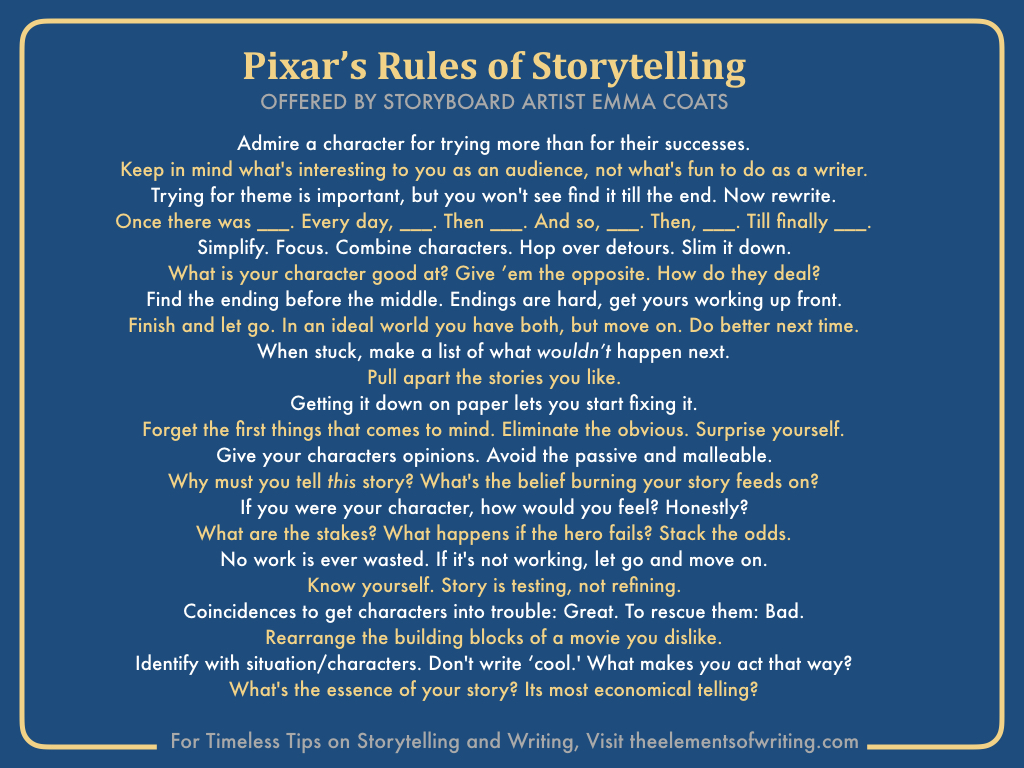So how does Pixar find its pixie dust? Magic? Inspiration? The Law of Attraction? Um, nope.
It’s hard, grinding work, with the insistence on getting all the big things — and all the little things — right. The process can hurt some precious feelings along the way. But it works.
 The storyboard artist Emma Coats has revealed the 22 rules of storytelling that produced hits like Inside Out, Onward, The Incredibles, and more.
The storyboard artist Emma Coats has revealed the 22 rules of storytelling that produced hits like Inside Out, Onward, The Incredibles, and more.
We can assume, given its raft of megahits, that the Pixar people know how to translate these narrative tricks into screen gold. But what if you need help applying storytelling skills into words?
In my book The Elements of Writing, I not only offer storytelling techniques, but also techniques for writing, style, and editing. How you express the story–in words–determines whether the characters and story come to life.
You can get a sense of my system with this outline of The Elements of Writing. After listing the writing skill, I offer a case study showing how to apply the skill. Most of the case studies come from great literature, film, and journalism.
The Core Idea—The Golden Rule of Writing
• Make Everything a Journey: Brent Staples’s “Black Men in Public Space’
• Start Strong, Finish Strong: William Nack’s Secretariat
• Take the Landscape View: Applying the Landscape View
Act I: Storytelling
1. Narrative
• Give Your Story a Narrative Arc: Truman Capote’s In Cold Blood
• For Complexity, Show More Than One Arc: Robert Caro’s The Passage of Power
• Show Characters Hitting Brick Walls: Homer’s The Odyssey
• Nest Journeys Inside Journeys: Andre Agassi’s Open
2. Characters
• Compile Dossiers for Your Characters: Sherlock Holmes
• Explore Characters’ Lives, Zone by Zone: Milan Kundera’s The Unbearable Lightness of Being
• Find Your Characters’ Throughlines: Heroes of the Civil Rights Movement
• Use the Wheel of Archetypes: L. Frank Baum’s The Wizard of Oz (55
• Spin the Wheel of Archetypes: Gregory Maguire’s Wicked
3. World of the Story (69
• Create Small, Knowable Places: Emma Donaghue’s Room
• Map the Character’s “Circles of Life”: Gay Talese’s ‘Frank Sinatra Has a Cold’
• Use Place to Explain Character and Ideas: Robert Caro’s The Path To Power
• Use Place to Explore Identity: Judith Ortiz Cofer’s Silent Dancing
• Place Stories in a Larger World: Henry Roth’s Call It Sleep
4. Action and Scenes
• Depict Specific, Deliberate Actions: Robert Penn Warren’s All the King’s Men
• Use Speech-Acts to Propel the Story: William Shakespeare’s Othello
• Build Actions into Scenes: William Shakespeare’s Macbeth
• Create a Mystery to Surprise the Reader: William Shakespeare’s Romeo and Juliet
5. Rhythm and Beats
• Use beats to Move Stories Forward: Casablanca
• Use Beats For Descriptions: Fatima Mernissi’s Dreams of Trespass
• Yo-Yo Scene and Summary: Elizabeth Gilbert’s ‘Lucky Jim’
6. Details
• Find Details By Looking Inside-Out: Isabel Chenoweth’s ‘Hanging Out’
• Isolate Details to Make Big Points: The New York Times ‘Portraits in Grief’
• Use Status Details to Reveal Ego and Desire: Tom Wolfe’s A Man in Full
• Put Details into Action: Journalism fragments
Intermission: On Style
7. The Senses
• Help the Reader to Feel: Scott Russell Sanders’s ‘Under the Influence’
• Help the Reader to See: Mark Twain’s Life on the Mississippi
• Help the Reader to Hear: Varieties of Onomatopoeia
8. Wordplay
• Tap Into Life’s Everyday Rhythms: Lincoln’s Gettysburg Address
• Use Metaphors and Similes to Orient and Disorient: Rick Reilly and Thomas Lunch
• Riff by Playing with Words: Roy Blount Jr.’s Alphabet Juice
• Remember that Good is Great: Tom Wolfe’s From Bauhaus to Our House
9. Numbers
• Use Ones to Highlight People, Places, and Issues: Ayn Rand’s The Fountainhead
• Use Twos to Establish Oppositions and Complements: The Yankees-Red Sox rivalry
• Use Threes to Reveal Dynamic Relations: Woody Allen’s Hannah and Her Sisters
• Use Lists to Show Complexity: Tim O’Brien’s The Things They Carried
Act II: Mechanics
10. Sentences
• Follow the Golden Rule for Sentences: Coverage of national Crises
• Give Every Sentence Clear Blasts: Ringo Starr and the Beatles
• Create Revolver Sentences: Stephen Crane’s Red Badge of Courage
• Make Some Sentences More Complicated: Stanley Fish’s How to Write a Sentence
• Alternate Short and Long Sentences: Ernest Hemingway’s journalism
11. Words
• Use Simple Words, Almost Always: John McPhee’s The Curve of Binding Energy and In Suspect Terrain
• Use Longer Words as Precision Instruments: The American Sesquipdalian
• Use Active Verbs, Even to Describe Passivity: Laura Hillenbrand’s Unbroken and Ivan Goncharov’s Oblomov
• Avoid the Verbs To Be and To Have: Using ‘to be’ and ‘to have’
• Avoid Bureaucratese and Empty-Calorie Words: George Orwell’s ‘The Politics of the English Language’
• Avoid Aggressive Adjectives and Adverbs: Tom Wolfe’s ‘The Girl of the Year’
12. Paragraphs (223)
• Make Every Paragraph an “Idea Bucket”: Journalism fragments
• Follow the Golden Rule in Every Paragraph: James Van Tholen’s ‘Surprised by Death’
• ‘Climb the Arc’ in Most Paragraphs: Martin Luther King’s ‘Mountaintop’ speech
13. Composition
• Make Every Piece a Journey: Theodore Dreiser’s Sister Carrie
• Find the Right Shape: The Bill Clinton story
• Slot Your Paragraphs: Malcolm Gladwell’s “The Terrazzo Jungle”
• Make Transitions Virginia Wolff’s ‘Ellen Terry’
Intermission: Technical Procedures
14. Grammar
• Make Sure the Parts of Speech Get Along: Approaches to the his/her problem
• Use Punctuation to Direct Traffic: Ernest Hemingway’s The Old Man and the Sea and Robert Caro’s The Passage of Power
• Select the Right Word: William Safire’s ‘On Language’
15. Editing
• Search and Destroy, From Big to Small: Marie Kondo’s The Life-Changing Magic of Tidying Up
• Fix Problem Paragraphs With Tabloid Headlines: John Stuart Mill’s On Liberty
• Edit by Reading Aloud and Backward: C.S. Lewis’s The Four Loves
• Murder Your Darlings: Raymond Carver’s ‘One More Thing’
Act III: Analysis
16. Storytelling for Analysis
• Narrate Complex Issues: Eugenie Ladner Birch’s ‘From Flames to Flowers’
• Use Beats to Make Arguments: On the Electoral College System
• Use Cliffhangers to Drive Analysis: Barry Bluestone’s ‘The Inequality Express’
• Use the Senses in Arguments and Rhetoric: Martin Luther King’s ‘I have a Dream’ Oration
• Allow Ideas To Unfold, One by One: ‘Falling Man’
17. Questions and Brainstorming
• To Get Started, Spill Your Mind: Brainstorming nonviolence
• Ask This-or-That and W Questions: Brian Lamb’s interviewing techniques
• Always Ask: What Causes What?: What’s the ‘best’ form of government?
18. Framing
• Use Testimony of Experts and Others: The Debate Over Global Warming
• Consider Hypotheticals and Scenarios: Social contract theorists
• Find a Super Model to Guide Analysis: Super models of social science
19. Making a Case
• Climb the “Ladder of Abstraction”: Garrison Keillor’s Lena and Ole Joke
• Identify and Operationalize Variables: The causes of fatigue
• Crunch the Numbers: Edward Glaeser on Urban Vitality
• Play the Game of Halves: Exploring the causes of war
Before you go . . .
• Like this content? For more posts on writing, visit the Elements of Writing Blog. Check out the posts on Storytelling, Writing Mechanics, Analysis, and Writers on Writing.
• For a monthly newsletter, chock full of hacks, interviews, and writing opportunities, sign up here.
• To transform writing in your organization, with in-person or online seminars, email us here for a free consultation.

